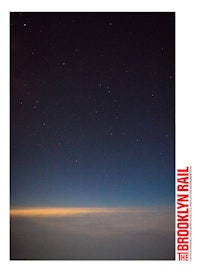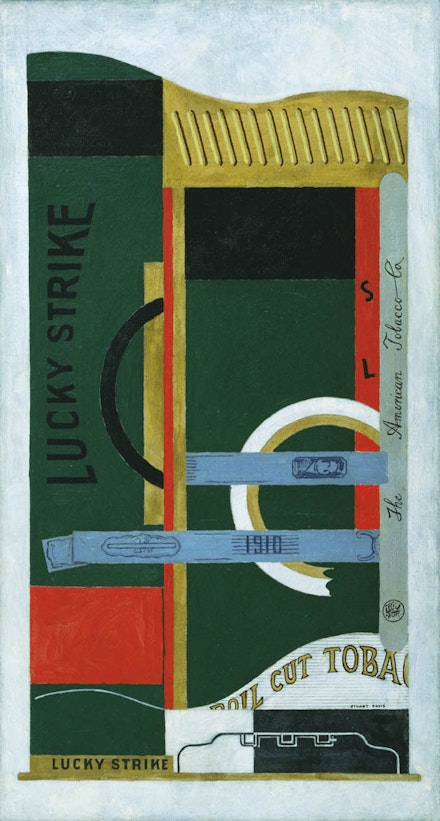ArtSeen
POPS STANDARD
STUART DAVIS In Full Swing
On View
The Whitney Museum Of American ArtJune 10 – September 25, 2016
New York
The logo-type signature that Stuart Davis affixed to all of his later compositions has the feel of an exuberantly but deliberately carved and cast-off orange peel. This shaped incorporation of the author with his works, which in many instances resemble a virtual junkyard of animate cast-offs, clearly signals Davis’s lifelong intention: to sublate an older genius of the exceptional subject into the oblivious, objective meander of the modern commons. In so doing he cranked up a rangy dialectical relationship between sign and image, order and chaos.1
Davis’s particular dialectical demons spoke in thickly recursive squiggles, cut-up poetics of the vernacular, adverbs and conjunctions, and delirious color combinations that approximate the lively swing of the burgeoning, outer-directed billboard of the American experience that found necessary realization on his blank canvases. During Davis’s lifetime, an overheated advertising culture took hold and began to seamlessly integrate—and eventually supplant—the customary language of form associated with the national landscape, which hewed more closely to the horizontality of the Hudson River School painters and the later (more “Okie baroque”) exemplars of Regionalism in Thomas Hart Benton and John Steuart Curry. Like Benton and Curry, Davis sought to capture the seething energy of a nation feeling its oats; unlike them, he was canny enough to realize that a new energy demanded an entirely new form: one that, rather than embodying the deep traditional values and corny anecdotes of popular culture, wore its illusory forms like jaunty tattoos, skin-deep but proliferate.
The shallow, shadowbox space that Davis’s works eventually occupied serves as a stage for allegorical plays on words and forms that express a compulsive busyness that didn’t require a coherent subjective message. His combination of generalized modernist forms with everyday language was his message: enduring hieroglyphs to be deciphered by subsequent generations equally distracted by the “let’s go, man!” imperative of restless American life. Nowadays, Davis’s multiple planes of color forms might imply the promiscuity of pop-up windows on computer screens or even just the feel, the intuition, of the ever stratifying heap of cast-off flavors of the minute that make up the dizzying arcades of our contemporary visual capital.
Davis’s style and content were strongly influenced by the Ashcan School-associated painter Robert Henri, with whom Davis began studying from at the age of sixteen. Henri encouraged Davis to derive his subject matter from the quotidian, and to express that immediacy in a bravura brushstroke. Davis took to heart this early aesthetic training in “looking outside” while evolving his medium to conform to the most contemporary examples in Cubism and Fauvism that he would have seen in the pivotal Armory Show of 1913, which also included Henri. (Davis himself was a participant in the show, which included five of his watercolors.)
By the early ’20s, Davis was sure enough of his own artistic voice to produce a remarkably accomplished and original series of paintings that includes Lucky Strike and Sweet Caporal (both 1921), which contain the elements (specific pop-cultural references/shallow, cubist compositions) that would come to characterize almost all of his work until his unfinished Fin (1962 – 64). In a way, these early works show that Davis sprung fully formed aesthetically from his own brow, perceptive of the constellation of signs that made up his common firmament, while courting his own muse slowly and deliberately, incorporating what he termed modern “objective” art theory (he disdained the term “abstract”) and practice from Picasso, Léger, and Miró, to name a few of the most important artists who influenced his style. These early works also recall the allegorical still lifes of John F. Peto and William Harnett; it seems that Davis derived as much sustenance from the influence of these presentational realists as he did from Cubism. He essentially acknowledges this hybrid influence in his titling of a later painting Colonial Cubism (1954).
These works were followed by more explicitly appropriated advertising in paintings such as Odol (1924), where the forms are reduced to just a few significant planar shifts and interpenetrating drawing. Davis continually reduced his formal syntax to the bare essentials while at the same time amping up the electricity of that syntax in the way in which he juxtaposed shapes, animated line, and fine tuned chromatic vibrations, like a band leader might conduct a syncopated arrangement of instruments and their sonic conglomeration.
Davis has scattered cues to this witty and kinetic sensibility throughout his work. Fragments of suggestive text hang, utterly contingent, in mid-composition declaring “Else,” “Any,” “XRD” (x-arty?). Consider the tangentially descriptive titles like Package Deal (1956), The Mellow Pad (1945 – 51), and Rapt at Rappaport’s (1951 – 52) that resound of jazzy wordplay like the roughly contemporary be-bop compositions “Round Midnight” and “Cookin’ At the Continental.” Like be-bop, Davis’s compositions tend to riff madly and then fold in on themselves in a tangle of overlapping and interpenetrating shapes and lines offset by rhythmic beats of high-key color. An early mural work originally commissioned by the Federal Art Project of the WPA, Swing Landscape (1938) seems to have been his major career breakthrough and is a spectacular painting to see in person. I would comfortably wager a bet between this very early “allover” composition in a heavyweight bout with Pollock’s One: Number 31, 1950 (1950). Davis’s approach would be more of the doggedly determined Frazier to Pollock’s dancing Ali, yet considering that Davis’s painting preceded the younger artist’s work by twelve years, one can’t deny the major influence that his synthesis of gesture and composition must have had on Pollock and many others. How would we view Pop Art, for instance, without his swinging signage syntax?
The exhibition documentation, including the catalogue with insightful texts by Barbara Haskell and Harry Cooper, presents Davis as a whole person, an artist of his times. From the mid-1930s through 1940, he was a collectively-engaged member of the Artists’ Committee of Action and the Artists Union, which published Art Front and led to the establishment of The American Artists’ Congress. Davis didn’t see abstraction as antithetical to the social but as a foundational element in a society based upon a healthy skepticism of formal dogma—an especially crucial position to take during the onset of National Socialism and later on the disillusionment of international socialist cadres with Stalin’s repressive régime. His political engagement has been shared in subsequent generations by generally inclusive collective action groups of such diverse purposes as the Art Workers’ Coalition (1969 – 71) and Group Material (1979 – 96) among many others. Davis always kept one foot firmly planted in the real flux and foment of daily aesthetics and political life, while with the other he tapped out the giddy dance steps of a nation in the throes of a seemingly perpetual teenage revelry.
Those days are long gone (if they ever had any staying traction); as in any historical survey of such an outwardly directed artist as Stuart Davis it would be tempting to wax nostalgic about the vitalism of his idiom playing to a nationalist imaginary. The great thing about this show is that one can appreciate the trans-generational genius of Davis without getting caught up in any nationalist subtext that might make his work just another pedantic billboard along the superhighway of American exceptionalism and/or the “package deals” of the new commissars of global neoliberalism. Davis managed to be integrally of his time, yet declined to simply reproduce a slavishly faithful picture of its tactical alibis. For this we can all get up and dance.
Endnotes
- James Elkins examines this same sensibility in another pragmatist thinker-in-signs, Charles Sanders Peirce. “In Peirce, as in no other semiotician, there is a ruthless dialectic between a desire for absolute, categorical order [. . .] and the equal, and incommensurate, interest in happy phenomenal chaos (geometrical planes, stuck doors, and the ‘feeling of red’),” from “What Does Peirce’s Sign Theory Have To Say To Art History?” Culture, Theory, and Critique, 44 (1), 2003: 5 – 22. Like Peirce, Davis’s dialectics tend to be open-ended and to sidestep any idealist synthesis.






